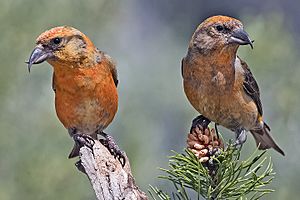Carduelinae facts for kids
Quick facts for kids Carduelinae |
|
|---|---|
 |
|
| male red crossbills | |
| Scientific classification |
|
| Kingdom: | Animalia |
| Phylum: | Chordata |
| Class: | Aves |
| Order: | Passeriformes |
| Family: | Fringillidae |
| Subfamily: | Carduelinae Vigors, 1825 |
| Genera | |
|
49, see text |
|
The cardueline finches are a group of birds known as a subfamily called Carduelinae. They are part of the larger Fringillidae family, which includes all finches. This group also includes the amazing Hawaiian honeycreepers, which are now considered part of the Carduelinae family.
Most cardueline finches are special because they eat seeds. Unlike many other birds that eat seeds, these finches feed their babies mostly seeds too, which they bring up from their stomachs. They are very good at opening seeds and holding onto plant stems to get them. Other seed-eating birds, like sparrows, usually just eat seeds that have fallen to the ground. Some cardueline finches are even more specialized. For example, crossbills have beaks designed to open pine cones to get the seeds inside!
These finches often fly and look for food in groups all year round. Instead of defending a specific area, the male finches protect their female partners. The name Carduelinae was given to this group by a zoologist named Nicholas Aylward Vigors in 1825. It comes from the Latin word carduelis, which is part of the scientific name for the European goldfinch.
Contents
What are Cardueline Finches?
Cardueline finches are a unique group within the finch family. They have special features that help them eat seeds.
Seed-Eating Experts
These birds are known as "granivores," meaning they eat seeds. They have strong beaks that are perfect for cracking open tough seeds. Unlike many other birds, cardueline finches feed their young mostly seeds. They do this by eating the seeds themselves and then bringing them back up to feed their chicks. This is a special way they care for their babies.
Life in Flocks
Cardueline finches usually live and travel in groups called flocks. They don't typically claim and defend a specific territory like some other birds do. Instead, the male finches focus on protecting their female partners. This way of living helps them find food and stay safe together.
Hawaiian Honeycreepers
The Hawaiian honeycreepers are a very interesting group of birds that are now part of the Carduelinae subfamily. They are famous for how they changed over time to fit different environments in Hawaii.
Amazing Adaptations
When honeycreepers first arrived in Hawaii, they found many different types of food. Over thousands of years, they developed many different beak shapes and sizes to eat various things, from nectar to insects to seeds. This process is called adaptive radiation, where one group of animals evolves into many different forms to fill different roles in nature.
Some Extinct Species
Sadly, many Hawaiian honeycreeper species are now extinct. This often happened because their habitats were destroyed, or new animals were brought to the islands that hunted them or competed for their food. Scientists work hard to protect the honeycreepers that are still alive today.
Types of Cardueline Finches
The Carduelinae subfamily is very large, with 186 different species. These species are grouped into 49 different genera. A genus is a group of closely related species.
Well-Known Genera
Here are some examples of the different types of finches found in this subfamily:
- Mycerobas: These are four types of large, strong-beaked finches from Asia, often called grosbeaks.
- Pyrrhula: This group includes the eight different species of bullfinches, known for their colorful feathers.
- Carpodacus: This is a large group with 28 species of rosefinches, found across Europe and Asia.
- Loxia: This genus contains the six species of crossbills, famous for their unique beaks that cross over at the tips, perfect for opening pine cones.
- Carduelis: This group includes the beautiful European goldfinch, which is well-known for its bright colors.
- Spinus: This genus has 20 species, including the North American goldfinches and the Eurasian siskin.
See also
 In Spanish: Carduelinae para niños
In Spanish: Carduelinae para niños

